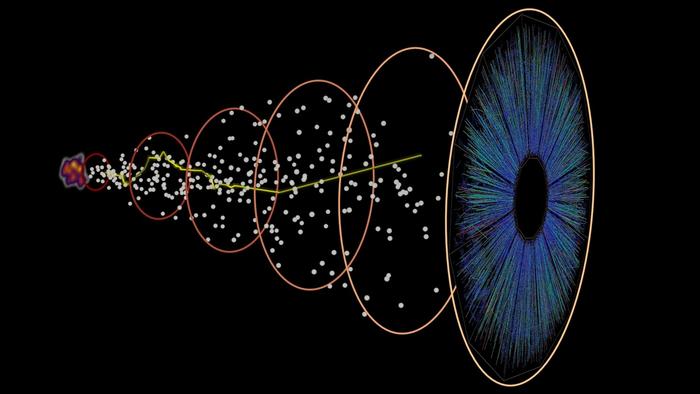
In a groundbreaking study, researchers from Eötvös Loránd University (ELTE) have uncovered remarkable insights into the intricate patterns of particle movement during high-energy nuclear collisions, revealing a phenomenon known as the Lévy walk, or Lévy flight. This random wandering pattern, attributed to the mathematician Paul Lévy, appears prominently across various natural processes. These include predators on the hunt for prey, the randomness of economic transactions, and even complex ecological dynamics. Notably, this research bridges multiple scientific fields, marking it as a novel endeavor in the exploration of particle physics and its relation to broader theoretical principles observed in nature.
The team, composed of Dániel Kincses, Márton Nagy, and Máté Csanád, utilized advanced simulation techniques to delve into the behavior of subatomic particles. Their findings demonstrate that the movement trajectories of particles in heavy-ion collisions directly conform to Lévy walk characteristics. Such a discovery not only confirms the interdisciplinary nature of Lévy walks but also enhances our understanding of particle dynamics at extreme energy levels, raising intriguing questions about the mechanisms governing their movement.
Researchers found that as particles traverse through the chaotic environments of nuclear collisions, their paths and distributions maintain a unique statistical resemblance to Lévy flights. These behaviors challenge conventional Gaussian models that typically describe particle distributions in physics. Instead, the results indicate that particle locations post-collision do not follow a typical bell curve distribution but instead exhibit a Lévy-stable distribution characterized by its slowly decaying probabilities. This revelation aligns with observations in other scientific domains, suggesting a universal principle governing randomness and spatial distribution present in different fields.
Furthermore, the study emphasized the importance of simulations in unraveling the complex dynamics of particle movements. The researchers noted that by meticulously tracking particle trajectories and measuring step lengths, they validated the application of Lévy statistics. This experimental approach sheds light on the intricate details of nuclear collisions, providing a more comprehensive understanding of how particles behave under extreme conditions, a topic of growing interest among nuclear physicists.
The implications of this research extend beyond theoretical confines. The results suggest that heavy-ion collisions involve underlying processes comparable to those observed in biological systems, ecological modeling, and even economic phenomena. The crossover in behavioral patterns indicates a potential unification of theories across disparate scientific realms, offering a fresh perspective on the chaotic nature of complex systems and the inherent randomness that governs them.
Central to this study is its contribution to the field of femtoscopy—a subdiscipline that investigates the spatio-temporal dynamics of nuclear collisions on femtosecond timescales. ELTE researchers have emerged as pioneering figures in femtoscopy, presenting their findings at major international conferences. The latest paper not only reinforces existing theories but also opens new avenues for experimental research. It highlights a need for further exploration into the origin of observed Lévy distributions, promoting a dialogue between theoretical models and experimental data.
In addition, this research bears significant implications for future particle accelerators and experiments. Understanding the Lévy walk dynamics could influence the design of experiments at facilities like CERN, where high-energy collisions are a critical focus. Such insights are expected to contribute to more accurate predictions concerning particle interactions and the fundamental forces that arise during collisions at unprecedented energy levels.
The interdisciplinary collaboration demonstrated in this study amplifies the significance of cross-domain approaches in modern scientific research. By engaging with concepts from economics and ecological systems, the researchers underscore the shared principles evident in the seemingly disparate fields. This convergence illustrates that randomness shapes not only particle physics but influences a wide array of complex systems observed in nature.
The findings have garnered attention for their potential to redefine how physicists approach particle dynamics. Rather than viewing movements strictly through established distributions, considering Lévy walks paves the way for a more nuanced analysis of randomness in particle behavior. This shift in perspective could lead to enhanced methodologies and experimental designs as the boundaries of particle physics continue to expand.
In conclusion, the study conducted by ELTE researchers catalyzes a significant shift in our understanding of particle behavior in high-energy environments. By framing particle trajectories within the context of Lévy walks, they offer a compelling narrative that intertwines various scientific disciplines. As the dialogue between theory and experiment grows stronger, the potential for groundbreaking discoveries seems vast, emphasizing the intricate beauty of randomness governing our natural and physical worlds.
Subject of Research: The dynamics of particles in heavy-ion collisions modeled as Lévy walks.
Article Title: Lévy walk of pions in heavy-ion collisions
News Publication Date: 5-Feb-2025
Web References: Interactive Graph, Dániel Kincses’s Profile, Recent Publication
References: DOI link: 10.1038/s42005-025-01973-x
Image Credits: Illustration by Mate Csanad / ELTE Eötvös Loránd University
Keywords
Climate change, Chemical processes, Theoretical physics, Nuclear physics, Atomic theory, Particle theory, Climate modeling, Stars
Tags: advanced simulation techniques in particle dynamicschaotic environments in particle movementclimate change impacts on particle physicsecological dynamics and random wanderingeconomic implications of particle behaviorEötvös Loránd University particle researchhigh-energy nuclear collision studiesinterdisciplinary research in physics and ecologyLévy walk in nuclear collisionsparticle physics and climate change connectionstatistical patterns in particle behaviorsubatomic particles and economic transactions





